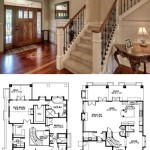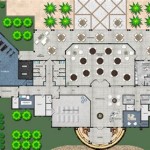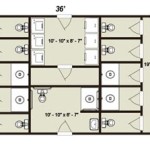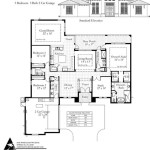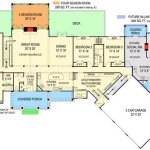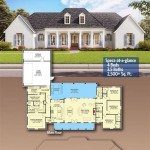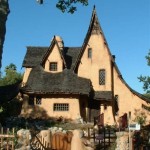House and Barn Combo Plans: A Comprehensive Guide
House and barn combo plans offer a unique living solution, combining residential comfort with functional workspace or storage. These structures, often referred to as "barndominiums," provide a versatile layout that can accommodate a variety of needs, from hobby farming to entrepreneurial ventures.
The appeal of a house and barn combo stems from its inherent flexibility. The barn section can house workshops, studios, storage for recreational vehicles, or even space for livestock. This allows individuals to pursue passions and businesses from the comfort of their own property. The attached living quarters offer the convenience and comfort of a traditional home, eliminating the need for separate structures.
Several key factors contribute to the increasing popularity of these combined structures. Land efficiency is a significant driver. Building a single structure that serves multiple purposes reduces the overall footprint compared to constructing separate buildings. This can be particularly advantageous in areas with limited space or where preserving natural surroundings is a priority.
Cost-effectiveness also plays a significant role. While the initial investment may seem substantial, combining the house and barn into one structure often results in lower overall construction costs compared to building two separate units. Shared walls, foundations, and utilities contribute to these savings. Furthermore, reduced maintenance costs associated with a single structure offer long-term financial benefits.
Customization is a hallmark of house and barn combo plans. Designs can be tailored to meet specific needs and preferences. The size and layout of both the living quarters and the barn section can be adjusted to accommodate different lifestyles and activities. This level of personalization allows for a truly bespoke living and working environment.
Choosing the right house and barn combo plan requires careful consideration of several factors. Determining the primary function of the barn area is crucial. Will it serve as a workshop, storage space, or a combination of uses? This will influence the size, layout, and features of the barn section.
The size and design of the living quarters should reflect the needs of the occupants. Considerations include the number of bedrooms and bathrooms, the layout of the kitchen and living areas, and the inclusion of features like a home office or a dedicated laundry room.
Budgetary considerations are essential. Establishing a realistic budget early in the planning process will help guide decisions about the size, materials, and features of the combined structure. Working with a qualified builder or architect can help ensure that the project stays within budget.
Local building codes and regulations must be carefully reviewed. These regulations can dictate aspects of the design, such as setbacks, height restrictions, and permitted materials. Obtaining the necessary permits and approvals before construction begins is essential.
The choice of building materials is another important consideration. Options range from traditional wood framing to steel and concrete construction. Each material offers different advantages in terms of cost, durability, and maintenance requirements. Factors like the local climate and aesthetic preferences can influence this decision.
Energy efficiency is a key aspect of modern building design. Incorporating energy-efficient features into the house and barn combo plan can result in long-term cost savings and reduced environmental impact. Features like insulation, energy-efficient windows, and solar panels can contribute to a more sustainable structure.
Working with experienced professionals is crucial throughout the planning and construction process. A qualified architect can help develop a design that meets specific needs and adheres to local building codes. A reputable builder can ensure that the project is completed to a high standard and within budget.
Site selection plays a significant role in the success of the project. Factors to consider include access to utilities, drainage, and the overall topography of the land. A thorough site assessment can help identify potential challenges and ensure that the chosen location is suitable for the combined structure.
Maintenance considerations should be factored into the design process. Choosing durable, low-maintenance materials can reduce the long-term upkeep required for the structure. Planning for easy access to utilities and systems can also simplify maintenance tasks.
The aesthetic appeal of the house and barn combo is an important consideration. The exterior design should complement the surrounding landscape and reflect the homeowner's personal style. Options range from rustic farmhouse aesthetics to modern and contemporary designs.
Exploring different house and barn combo plans is essential before making a final decision. Online resources, architectural publications, and visits to existing barndominiums can provide valuable inspiration and insights. Careful consideration of the various design options will ensure that the chosen plan meets both functional and aesthetic goals.
Financing a house and barn combo project requires careful planning. Exploring different financing options, such as construction loans and mortgages, is essential. Working with a financial advisor can help determine the best approach based on individual circumstances.

House Design With Combo And Barn Google Search Plan Loft Pole Plans Barndominium Floor

House With Barn Plans Horse

Image Result For House Design With Combo And Pole Barn Plans Homes Floor

Image Result For House Combo Floor Plans Pole Barn Barndominium

Colonial Series Harvest Moon Timber Frame

Barndominium Floor Plans Pole Barn House And Metal Homes

Timber Frame Barn Kits Harvest Moon

Learn About Pole Barn Homes And Houses Wick Buildings

The 5 Best Barndominium Plans With Living Quarters

Covered Riding Arena And Barn With Living Quarters Dc Structures Blog

